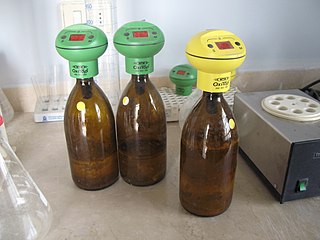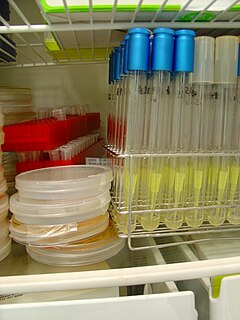Related Research Articles
Food preservation includes food processing practices which prevent the growth of microorganisms, such as yeasts, and slow the oxidation of fats that cause rancidity. Food preservation may also include processes that inhibit visual deterioration, such as the enzymatic browning reaction in apples after they are cut during food preparation. By preserving food, food waste can be reduced, which is an important way to decrease production costs and increase the efficiency of food systems, improve food security and nutrition and contribute towards environmental sustainability. For instance, it can reduce the environmental impact of food production.

A microorganism, or microbe, is an organism of microscopic size, which may exist in its single-celled form or as a colony of cells.

Sterilization refers to any process that removes, kills, or deactivates all forms of life and other biological agents such as prions present in or on a specific surface, object, or fluid. Sterilization can be achieved through various means, including heat, chemicals, irradiation, high pressure, and filtration. Sterilization is distinct from disinfection, sanitization, and pasteurization, in that those methods reduce rather than eliminate all forms of life and biological agents present. After sterilization, an object is referred to as being sterile or aseptic.

Biochemical oxygen demand (BOD) is the amount of dissolved oxygen (DO) needed by aerobic biological organisms to break down organic material present in a given water sample at certain temperature over a specific time period. The BOD value is most commonly expressed in milligrams of oxygen consumed per litre of sample during 5 days of incubation at 20 °C and is often used as a surrogate of the degree of organic pollution of water.

A microbiological culture, or microbial culture, is a method of multiplying microbial organisms by letting them reproduce in predetermined culture medium under controlled laboratory conditions. Microbial cultures are foundational and basic diagnostic methods used as a research tool in molecular biology.
An antimicrobial is an agent that kills microorganisms or stops their growth. Antimicrobial medicines can be grouped according to the microorganisms they act primarily against. For example, antibiotics are used against bacteria, and antifungals are used against fungi. They can also be classified according to their function. Agents that kill microbes are microbicides, while those that merely inhibit their growth are called bacteriostatic agents. The use of antimicrobial medicines to treat infection is known as antimicrobial chemotherapy, while the use of antimicrobial medicines to prevent infection is known as antimicrobial prophylaxis.

"F0" is defined as the number of equivalent minutes of steam sterilization at temperature 121.1 °C (250 °F) delivered to a container or unit of product calculated using a z-value of 10 °C. The term F-value or "FTref/z" is defined as the equivalent number of minutes to a certain reference temperature (Tref) for a certain control microorganism with an established Z-value.

Food microbiology is the study of the microorganisms that inhabit, create, or contaminate food. This includes the study of microorganisms causing food spoilage; pathogens that may cause disease ; microbes used to produce fermented foods such as cheese, yogurt, bread, beer, and wine; and microbes with other useful roles, such as producing probiotics.
Thermal death time is how long it takes to kill a specific bacterium at a specific temperature. It was originally developed for food canning and has found applications in cosmetics, producing salmonella-free feeds for animals and pharmaceuticals.
In microbiology, sterility assurance level (SAL) is the probability that a single unit that has been subjected to sterilization nevertheless remains nonsterile.

Medical microbiology, the large subset of microbiology that is applied to medicine, is a branch of medical science concerned with the prevention, diagnosis and treatment of infectious diseases. In addition, this field of science studies various clinical applications of microbes for the improvement of health. There are four kinds of microorganisms that cause infectious disease: bacteria, fungi, parasites and viruses, and one type of infectious protein called prion.

Microbiology is the scientific study of microorganisms, those being unicellular, multicellular, or acellular. Microbiology encompasses numerous sub-disciplines including virology, bacteriology, protistology, mycology, immunology and parasitology.
A Biological Indicator Evaluation Resistometer (BIER) vessel is a piece of equipment used to determine the time taken to reduce survival of a given organism by 90%. The name derives from how the equipment is used.

Water activity (aw) is the partial vapor pressure of water in a solution divided by the standard state partial vapor pressure of water. In the field of food science, the standard state is most often defined as pure water at the same temperature. Using this particular definition, pure distilled water has a water activity of exactly one. Water activity is the thermodynamic activity of water as solvent and the relative humidity of the surrounding air after equilibration. As temperature increases, aw typically increases, except in some products with crystalline salt or sugar.
Pascalization, bridgmanization, high pressure processing (HPP) or high hydrostatic pressure (HHP) processing is a method of preserving and sterilizing food, in which a product is processed under very high pressure, leading to the inactivation of certain microorganisms and enzymes in the food. HPP has a limited effect on covalent bonds within the food product, thus maintaining both the sensory and nutritional aspects of the product. The technique was named after Blaise Pascal, a French scientist of the 17th century whose work included detailing the effects of pressure on fluids. During pascalization, more than 50,000 pounds per square inch may be applied for around fifteen minutes, leading to the inactivation of yeast, mold, and bacteria. Pascalization is also known as bridgmanization, named for physicist Percy Williams Bridgman.
Microbes can be damaged or killed by elements of their physical environment such as temperature, radiation, or exposure to chemicals; these effects can be exploited in efforts to control pathogens, often for the purpose of food safety.
Microbial biogeography is a subset of biogeography, a field that concerns the distribution of organisms across space and time. Although biogeography traditionally focused on plants and larger animals, recent studies have broadened this field to include distribution patterns of microorganisms. This extension of biogeography to smaller scales—known as "microbial biogeography"—is enabled by ongoing advances in genetic technologies.

Industrial microbiology is a branch of biotechnology that applies microbial sciences to create industrial products in mass quantities, often using microbial cell factories. There are multiple ways to manipulate a microorganism in order to increase maximum product yields. Introduction of mutations into an organism may be accomplished by introducing them to mutagens. Another way to increase production is by gene amplification, this is done by the use of plasmids, and vectors. The plasmids and/ or vectors are used to incorporate multiple copies of a specific gene that would allow more enzymes to be produced that eventually cause more product yield. The manipulation of organisms in order to yield a specific product has many applications to the real world like the production of some antibiotics, vitamins, enzymes, amino acids, solvents, alcohol and daily products. Microorganisms play a big role in the industry, with multiple ways to be used. Medicinally, microbes can be used for creating antibiotics in order to treat infection. Microbes can also be used for the food industry as well. Microbes are very useful in creating some of the mass produced products that are consumed by people. The chemical industry also uses microorganisms in order to synthesize amino acids and organic solvents. Microbes can also be used in an agricultural application for use as a biopesticide instead of using dangerous chemicals and or inoculants to help plant proliferation.

The branches of microbiology can be classified into pure and applied sciences. Microbiology can be also classified based on taxonomy, in the cases of bacteriology, mycology, protozoology, and phycology. There is considerable overlap between the specific branches of microbiology with each other and with other disciplines, and certain aspects of these branches can extend beyond the traditional scope of microbiology In general the field of microbiology can be divided in the more fundamental branch and the applied microbiology (biotechnology). In the more fundamental field the organisms are studied as the subject itself on a deeper (theoretical) level. Applied microbiology refers to the fields where the micro-organisms are applied in certain processes such as brewing or fermentation. The organisms itself are often not studied as such, but applied to sustain certain processes.
Food and biological process engineering is a discipline concerned with applying principles of engineering to the fields of food production and distribution and biology. It is a broad field, with workers fulfilling a variety of roles ranging from design of food processing equipment to genetic modification of organisms. In some respects it is a combined field, drawing from the disciplines of food science and biological engineering to improve the earth's food supply.
References
- ↑ U.S. Food and Drug Administration. "Inspection Guides - Sterilizing Symbols (D, Z, F)". www.fda.gov. Retrieved 2018-09-28.
- ↑ Channaiah, Lakshmikantha H.; Michael, Minto; Acuff, Jennifer C.; Lopez, Keyla; Phebus, Randall K.; Thippareddi, Harshavardhan; Milliken, George (2019-04-02). "Validation of a nut muffin baking process and thermal resistance characterization of a 7-serovar Salmonella inoculum in batter when introduced via flour or walnuts". International Journal of Food Microbiology. 294: 27–30. doi: 10.1016/j.ijfoodmicro.2019.01.013 . ISSN 0168-1605. PMID 30739832.
- ↑ Priscila Gava Mazzola, Thereza Christina Vessoni Penna, Alzira M da S Martins (17 October 2003). "Determination of decimal reduction time (D value) of chemical agents used in hospitals for disinfection purposes". BMC Infectious Diseases. 3: 24. doi:10.1186/1471-2334-3-24. PMC 270032 . PMID 14563217.
{{cite journal}}: CS1 maint: multiple names: authors list (link)